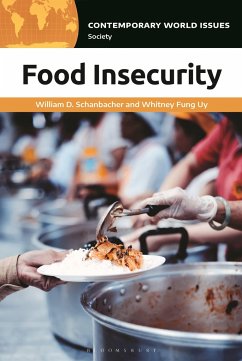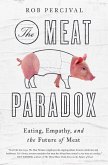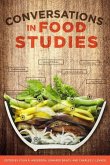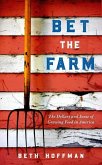William D Schanbacher, Whitney Fung UyA Reference Handbook
Food Insecurity
A Reference Handbook
Herausgeber: Vasan, Mildred
William D Schanbacher, Whitney Fung UyA Reference Handbook
Food Insecurity
A Reference Handbook
Herausgeber: Vasan, Mildred
- Gebundenes Buch
- Merkliste
- Auf die Merkliste
- Bewerten Bewerten
- Teilen
- Produkt teilen
- Produkterinnerung
- Produkterinnerung
This comprehensive and authoritative one-stop resource examines the issue of food insecurity in the United States, including the various economic, social, political, and cultural factors that drive the problem. Social welfare agencies, schools, food banks, and other organizations have all put forth efforts to combat food insecurity, but it remains a serious risk for millions of poor Americans today. Food Insecurity: A Reference Handbook examines the reasons why food insecurity remains such a longstanding problem in American society. Beginning with a history of food insecurity from the…mehr
Andere Kunden interessierten sich auch für
![The Meat Paradox The Meat Paradox]() Rob PercivalThe Meat Paradox22,99 €
Rob PercivalThe Meat Paradox22,99 €![Conversations in Food Studies Conversations in Food Studies]() Conversations in Food Studies67,99 €
Conversations in Food Studies67,99 €![The Secret Life of Groceries The Secret Life of Groceries]() Benjamin LorrThe Secret Life of Groceries38,99 €
Benjamin LorrThe Secret Life of Groceries38,99 €![The Global Japanese Restaurant The Global Japanese Restaurant]() The Global Japanese Restaurant84,99 €
The Global Japanese Restaurant84,99 €![Bet the Farm Bet the Farm]() Beth HoffmanBet the Farm23,99 €
Beth HoffmanBet the Farm23,99 €![Milk Craze Milk Craze]() Veronica S W MakMilk Craze79,99 €
Veronica S W MakMilk Craze79,99 €![French Gastronomy in the US French Gastronomy in the US]() Thérèse Migraine-GeorgeFrench Gastronomy in the US182,99 €
Thérèse Migraine-GeorgeFrench Gastronomy in the US182,99 €-
-
-
This comprehensive and authoritative one-stop resource examines the issue of food insecurity in the United States, including the various economic, social, political, and cultural factors that drive the problem. Social welfare agencies, schools, food banks, and other organizations have all put forth efforts to combat food insecurity, but it remains a serious risk for millions of poor Americans today. Food Insecurity: A Reference Handbook examines the reasons why food insecurity remains such a longstanding problem in American society. Beginning with a history of food insecurity from the country's origins to the present day, the book also delves into the problems and controversies related to food insecurity, such as urban food deserts, substance abuse impacts, nutrition education, and income inequality. One of the most valuable aspects of the book is that it surveys the history of food insecurity in a manner that helps the reader identify key issues in an easy-to-understand fashion. The book's Perspectives chapter presents a broad range of voices on various facets of food insecurity, providing crucial, diverse perspectives to round out the coverage and expertise of the authors.
Produktdetails
- Produktdetails
- Verlag: Bloomsbury Academic
- Seitenzahl: 440
- Erscheinungstermin: 21. September 2023
- Englisch
- Abmessung: 232mm x 161mm x 25mm
- Gewicht: 830g
- ISBN-13: 9781440878398
- ISBN-10: 1440878390
- Artikelnr.: 68486248
- Herstellerkennzeichnung
- Libri GmbH
- Europaallee 1
- 36244 Bad Hersfeld
- gpsr@libri.de
- Verlag: Bloomsbury Academic
- Seitenzahl: 440
- Erscheinungstermin: 21. September 2023
- Englisch
- Abmessung: 232mm x 161mm x 25mm
- Gewicht: 830g
- ISBN-13: 9781440878398
- ISBN-10: 1440878390
- Artikelnr.: 68486248
- Herstellerkennzeichnung
- Libri GmbH
- Europaallee 1
- 36244 Bad Hersfeld
- gpsr@libri.de
William D. Schanbacher and Whitney Fung Uy
Preface
1. Background and History
Introduction
The Narrative We Tell about Food History
Origins of Food Insecurity in the Colonial Period (1600- 1775)
- The Transatlantic Slave Trade and Origins of Black Food Insecurity
Revolutionary War to the Civil War (1776- 1865)
- Westward Expansion, Treaties, Removal Policies, and Land as Food Security
- Native American Women in Westward Expansion
- The Civil War Era (1861- 1865)
Reconstruction Era (1865- 1877)
Progressive Era (1890s- 1920s)
The Great Depression and New Deal Era (1920- 1940)
Post War Era (1945- 1960)
- Women in the Industrial Food System
The Civil Rights Era (1960- 1980)
End of the Century (1980- 2000s)
- Food Processing
- Globalization and Expansion of the Food Industry
- Food Marketing
- Dietary Guidelines and Recommendations
The Social Safety Net: Responses to Food Insecurity
- USDA Food and Nutrition Assistance Programs
Conclusion: Food Insecurity Today
References
2. Problems, Controversies, and Solutions
Framing the Discussion for Problems, Controversies, and Solutions
Defining and Measuring Food Insecurity
- Globally Recognized Definition of Food Insecurity
- United States Definition
- Other Key Terms
- Levels of Food Insecurity
- Tools for Assessing Food Security Status
Inequity in the Food System
- Inequitable Access to Land
- Geographical Disparities: Access to Food
- Impact of Health Inequities
Sustainability of the Food System
- A Sustainable, Closed- Loop Food System
Agricultural Development and Food Production
- The Green Revolution
- Genetically Modified Foods
- Seeds
Corporate Control of Food System
The Debate: Food as a Human Right
Solutions
- New Food Movements
- Building Capacity of U.S. Farmers: Rural and Urban
- Food, Agriculture, and Grocery Cooperatives
- Food Policy Councils
- Food Justice
- Women in the Food System
- Food Sovereignty
- Implementing Food Sovereignty and Food Security
- Toward a Secure Future
References
3. Perspectives
From an Anti- hunger Activist: My Perspective on Ending Hunger in America,
Minerva Delgado
Food Sovereignty in Rural Appalachia, Nicole Rasul
Moving the Charitable Food System from Transactions to Transformations,
Katie S. Martin
A Plan to Shorten Food Bank Lines, Andy Fisher
Stories Matter: Narrative Change as a Strategy for Exposing the Root Causes
of Hunger and Spurring Collective Action, Alison Meares Cohen and Debbie
DePoala
Focusing on Racial Equity to End Hunger, Marlysa D. Gamblin
Native American Food Security and Food Sovereignty, Elizabeth Hoover
Food Policy Councils and the Challenge of Incorporating Justice, Equity,
Diversity, and Inclusion, Erica Hall
Food and Nutrition Education for Food Sovereignty, Pamela Koch
Advancing Nutrition Security with Sustainability Research, Sarah Reinhardt
4. Profiles
Introduction
People
- George Washington Carver (1864- 1943)
- Cesar Chavez (1927- 1993)
- W.E.B. Du Bois (1868- 1963)
- Fannie Lou Hamer (1917- 1977)
- Vandana Shiva (1952- )
- Booker T. Washington (1856- 1915)
Organizations
- Black Panther Party
- Bread for the World
- Coalition of Immokalee Workers
- College and University Food Bank Alliance
- Feeding America
- Food and Agriculture Organization of the United Nations
- Food and Resource Action Center
- Food Chain Workers Alliance
- Food Policy Networks
- Food Recovery Network
- La Via Campesina
- National Farm to School Network
- Share Our Strength
- Slow Food Movement
- United States Department of Agriculture
5. Data and Documents
Data
- Figure 5.1: Trends in Food Insecurity Rates in U.S. Households from 1995
to 2021
- Figure 5.2: Prevalence of Food Insecurity (Three- year Averages from
2019- 2021) by State in the United States
- Figure 5.3: Characteristics of Households Experiencing Very Low Food
Security in 2021
- Figure 5.4: Trends in Food Insecurity Prevalence in the United States by
Race and Ethnicity from 2001 to 2021
- Table 5.1: Food Insecurity Rates in the United States by Race and Other
Characteristics in 2017
- Table 5.2: Food Insecurity Rates in the United States among Southeast
Asians by Ethnicity
- Figure 5.5: Spending on Federal Food Assistance Programs from 1980 to
2021
- Table 5.3: National Annual and Monthly Data on the Supplemental Nutrition
Assistance Program
- Figure 5.6: Map of Farmers Markets in the United States That Accept SNAP
in 2018
- Table 5.4: Comparison of U.S. Agricultural Characteristics in 1860 and
2010
- Table 5.5: Carbon Impact of Select Food Products by Kilogram of
Greenhouse Gas Emission
- Table 5.6: Environmental Impacts of Food and Agriculture
Documents
- United Nations Declaration of Human Rights (UNDHR)
- United Nation's Covenant on Social, Economic and Cultural Rights (ICESCR)
- H.R. 2- Agriculture Improvement Act of 2018, Public Law 115- 334
- General Allotment or Dawes Act (1887)
- Lone Wolf v. Hitchcock
- Treaty of New Echota
- Pigford et al. v. Glickman
- Monsanto v. Percey Schmeiser
- Coalition of Immokalee Workers Fair Food Code of Conduct
- Equal Opportunity in Farm Programs: An Appraisal of Services Rendered by
Agencies of the United States Department of Agriculture
- Declaration of Nyéléni
6. Resources
Books
Journals and Articles
Reports
Online Resources
7. Chronology
Glossary
Index
1. Background and History
Introduction
The Narrative We Tell about Food History
Origins of Food Insecurity in the Colonial Period (1600- 1775)
- The Transatlantic Slave Trade and Origins of Black Food Insecurity
Revolutionary War to the Civil War (1776- 1865)
- Westward Expansion, Treaties, Removal Policies, and Land as Food Security
- Native American Women in Westward Expansion
- The Civil War Era (1861- 1865)
Reconstruction Era (1865- 1877)
Progressive Era (1890s- 1920s)
The Great Depression and New Deal Era (1920- 1940)
Post War Era (1945- 1960)
- Women in the Industrial Food System
The Civil Rights Era (1960- 1980)
End of the Century (1980- 2000s)
- Food Processing
- Globalization and Expansion of the Food Industry
- Food Marketing
- Dietary Guidelines and Recommendations
The Social Safety Net: Responses to Food Insecurity
- USDA Food and Nutrition Assistance Programs
Conclusion: Food Insecurity Today
References
2. Problems, Controversies, and Solutions
Framing the Discussion for Problems, Controversies, and Solutions
Defining and Measuring Food Insecurity
- Globally Recognized Definition of Food Insecurity
- United States Definition
- Other Key Terms
- Levels of Food Insecurity
- Tools for Assessing Food Security Status
Inequity in the Food System
- Inequitable Access to Land
- Geographical Disparities: Access to Food
- Impact of Health Inequities
Sustainability of the Food System
- A Sustainable, Closed- Loop Food System
Agricultural Development and Food Production
- The Green Revolution
- Genetically Modified Foods
- Seeds
Corporate Control of Food System
The Debate: Food as a Human Right
Solutions
- New Food Movements
- Building Capacity of U.S. Farmers: Rural and Urban
- Food, Agriculture, and Grocery Cooperatives
- Food Policy Councils
- Food Justice
- Women in the Food System
- Food Sovereignty
- Implementing Food Sovereignty and Food Security
- Toward a Secure Future
References
3. Perspectives
From an Anti- hunger Activist: My Perspective on Ending Hunger in America,
Minerva Delgado
Food Sovereignty in Rural Appalachia, Nicole Rasul
Moving the Charitable Food System from Transactions to Transformations,
Katie S. Martin
A Plan to Shorten Food Bank Lines, Andy Fisher
Stories Matter: Narrative Change as a Strategy for Exposing the Root Causes
of Hunger and Spurring Collective Action, Alison Meares Cohen and Debbie
DePoala
Focusing on Racial Equity to End Hunger, Marlysa D. Gamblin
Native American Food Security and Food Sovereignty, Elizabeth Hoover
Food Policy Councils and the Challenge of Incorporating Justice, Equity,
Diversity, and Inclusion, Erica Hall
Food and Nutrition Education for Food Sovereignty, Pamela Koch
Advancing Nutrition Security with Sustainability Research, Sarah Reinhardt
4. Profiles
Introduction
People
- George Washington Carver (1864- 1943)
- Cesar Chavez (1927- 1993)
- W.E.B. Du Bois (1868- 1963)
- Fannie Lou Hamer (1917- 1977)
- Vandana Shiva (1952- )
- Booker T. Washington (1856- 1915)
Organizations
- Black Panther Party
- Bread for the World
- Coalition of Immokalee Workers
- College and University Food Bank Alliance
- Feeding America
- Food and Agriculture Organization of the United Nations
- Food and Resource Action Center
- Food Chain Workers Alliance
- Food Policy Networks
- Food Recovery Network
- La Via Campesina
- National Farm to School Network
- Share Our Strength
- Slow Food Movement
- United States Department of Agriculture
5. Data and Documents
Data
- Figure 5.1: Trends in Food Insecurity Rates in U.S. Households from 1995
to 2021
- Figure 5.2: Prevalence of Food Insecurity (Three- year Averages from
2019- 2021) by State in the United States
- Figure 5.3: Characteristics of Households Experiencing Very Low Food
Security in 2021
- Figure 5.4: Trends in Food Insecurity Prevalence in the United States by
Race and Ethnicity from 2001 to 2021
- Table 5.1: Food Insecurity Rates in the United States by Race and Other
Characteristics in 2017
- Table 5.2: Food Insecurity Rates in the United States among Southeast
Asians by Ethnicity
- Figure 5.5: Spending on Federal Food Assistance Programs from 1980 to
2021
- Table 5.3: National Annual and Monthly Data on the Supplemental Nutrition
Assistance Program
- Figure 5.6: Map of Farmers Markets in the United States That Accept SNAP
in 2018
- Table 5.4: Comparison of U.S. Agricultural Characteristics in 1860 and
2010
- Table 5.5: Carbon Impact of Select Food Products by Kilogram of
Greenhouse Gas Emission
- Table 5.6: Environmental Impacts of Food and Agriculture
Documents
- United Nations Declaration of Human Rights (UNDHR)
- United Nation's Covenant on Social, Economic and Cultural Rights (ICESCR)
- H.R. 2- Agriculture Improvement Act of 2018, Public Law 115- 334
- General Allotment or Dawes Act (1887)
- Lone Wolf v. Hitchcock
- Treaty of New Echota
- Pigford et al. v. Glickman
- Monsanto v. Percey Schmeiser
- Coalition of Immokalee Workers Fair Food Code of Conduct
- Equal Opportunity in Farm Programs: An Appraisal of Services Rendered by
Agencies of the United States Department of Agriculture
- Declaration of Nyéléni
6. Resources
Books
Journals and Articles
Reports
Online Resources
7. Chronology
Glossary
Index
Preface
1. Background and History
Introduction
The Narrative We Tell about Food History
Origins of Food Insecurity in the Colonial Period (1600- 1775)
- The Transatlantic Slave Trade and Origins of Black Food Insecurity
Revolutionary War to the Civil War (1776- 1865)
- Westward Expansion, Treaties, Removal Policies, and Land as Food Security
- Native American Women in Westward Expansion
- The Civil War Era (1861- 1865)
Reconstruction Era (1865- 1877)
Progressive Era (1890s- 1920s)
The Great Depression and New Deal Era (1920- 1940)
Post War Era (1945- 1960)
- Women in the Industrial Food System
The Civil Rights Era (1960- 1980)
End of the Century (1980- 2000s)
- Food Processing
- Globalization and Expansion of the Food Industry
- Food Marketing
- Dietary Guidelines and Recommendations
The Social Safety Net: Responses to Food Insecurity
- USDA Food and Nutrition Assistance Programs
Conclusion: Food Insecurity Today
References
2. Problems, Controversies, and Solutions
Framing the Discussion for Problems, Controversies, and Solutions
Defining and Measuring Food Insecurity
- Globally Recognized Definition of Food Insecurity
- United States Definition
- Other Key Terms
- Levels of Food Insecurity
- Tools for Assessing Food Security Status
Inequity in the Food System
- Inequitable Access to Land
- Geographical Disparities: Access to Food
- Impact of Health Inequities
Sustainability of the Food System
- A Sustainable, Closed- Loop Food System
Agricultural Development and Food Production
- The Green Revolution
- Genetically Modified Foods
- Seeds
Corporate Control of Food System
The Debate: Food as a Human Right
Solutions
- New Food Movements
- Building Capacity of U.S. Farmers: Rural and Urban
- Food, Agriculture, and Grocery Cooperatives
- Food Policy Councils
- Food Justice
- Women in the Food System
- Food Sovereignty
- Implementing Food Sovereignty and Food Security
- Toward a Secure Future
References
3. Perspectives
From an Anti- hunger Activist: My Perspective on Ending Hunger in America,
Minerva Delgado
Food Sovereignty in Rural Appalachia, Nicole Rasul
Moving the Charitable Food System from Transactions to Transformations,
Katie S. Martin
A Plan to Shorten Food Bank Lines, Andy Fisher
Stories Matter: Narrative Change as a Strategy for Exposing the Root Causes
of Hunger and Spurring Collective Action, Alison Meares Cohen and Debbie
DePoala
Focusing on Racial Equity to End Hunger, Marlysa D. Gamblin
Native American Food Security and Food Sovereignty, Elizabeth Hoover
Food Policy Councils and the Challenge of Incorporating Justice, Equity,
Diversity, and Inclusion, Erica Hall
Food and Nutrition Education for Food Sovereignty, Pamela Koch
Advancing Nutrition Security with Sustainability Research, Sarah Reinhardt
4. Profiles
Introduction
People
- George Washington Carver (1864- 1943)
- Cesar Chavez (1927- 1993)
- W.E.B. Du Bois (1868- 1963)
- Fannie Lou Hamer (1917- 1977)
- Vandana Shiva (1952- )
- Booker T. Washington (1856- 1915)
Organizations
- Black Panther Party
- Bread for the World
- Coalition of Immokalee Workers
- College and University Food Bank Alliance
- Feeding America
- Food and Agriculture Organization of the United Nations
- Food and Resource Action Center
- Food Chain Workers Alliance
- Food Policy Networks
- Food Recovery Network
- La Via Campesina
- National Farm to School Network
- Share Our Strength
- Slow Food Movement
- United States Department of Agriculture
5. Data and Documents
Data
- Figure 5.1: Trends in Food Insecurity Rates in U.S. Households from 1995
to 2021
- Figure 5.2: Prevalence of Food Insecurity (Three- year Averages from
2019- 2021) by State in the United States
- Figure 5.3: Characteristics of Households Experiencing Very Low Food
Security in 2021
- Figure 5.4: Trends in Food Insecurity Prevalence in the United States by
Race and Ethnicity from 2001 to 2021
- Table 5.1: Food Insecurity Rates in the United States by Race and Other
Characteristics in 2017
- Table 5.2: Food Insecurity Rates in the United States among Southeast
Asians by Ethnicity
- Figure 5.5: Spending on Federal Food Assistance Programs from 1980 to
2021
- Table 5.3: National Annual and Monthly Data on the Supplemental Nutrition
Assistance Program
- Figure 5.6: Map of Farmers Markets in the United States That Accept SNAP
in 2018
- Table 5.4: Comparison of U.S. Agricultural Characteristics in 1860 and
2010
- Table 5.5: Carbon Impact of Select Food Products by Kilogram of
Greenhouse Gas Emission
- Table 5.6: Environmental Impacts of Food and Agriculture
Documents
- United Nations Declaration of Human Rights (UNDHR)
- United Nation's Covenant on Social, Economic and Cultural Rights (ICESCR)
- H.R. 2- Agriculture Improvement Act of 2018, Public Law 115- 334
- General Allotment or Dawes Act (1887)
- Lone Wolf v. Hitchcock
- Treaty of New Echota
- Pigford et al. v. Glickman
- Monsanto v. Percey Schmeiser
- Coalition of Immokalee Workers Fair Food Code of Conduct
- Equal Opportunity in Farm Programs: An Appraisal of Services Rendered by
Agencies of the United States Department of Agriculture
- Declaration of Nyéléni
6. Resources
Books
Journals and Articles
Reports
Online Resources
7. Chronology
Glossary
Index
1. Background and History
Introduction
The Narrative We Tell about Food History
Origins of Food Insecurity in the Colonial Period (1600- 1775)
- The Transatlantic Slave Trade and Origins of Black Food Insecurity
Revolutionary War to the Civil War (1776- 1865)
- Westward Expansion, Treaties, Removal Policies, and Land as Food Security
- Native American Women in Westward Expansion
- The Civil War Era (1861- 1865)
Reconstruction Era (1865- 1877)
Progressive Era (1890s- 1920s)
The Great Depression and New Deal Era (1920- 1940)
Post War Era (1945- 1960)
- Women in the Industrial Food System
The Civil Rights Era (1960- 1980)
End of the Century (1980- 2000s)
- Food Processing
- Globalization and Expansion of the Food Industry
- Food Marketing
- Dietary Guidelines and Recommendations
The Social Safety Net: Responses to Food Insecurity
- USDA Food and Nutrition Assistance Programs
Conclusion: Food Insecurity Today
References
2. Problems, Controversies, and Solutions
Framing the Discussion for Problems, Controversies, and Solutions
Defining and Measuring Food Insecurity
- Globally Recognized Definition of Food Insecurity
- United States Definition
- Other Key Terms
- Levels of Food Insecurity
- Tools for Assessing Food Security Status
Inequity in the Food System
- Inequitable Access to Land
- Geographical Disparities: Access to Food
- Impact of Health Inequities
Sustainability of the Food System
- A Sustainable, Closed- Loop Food System
Agricultural Development and Food Production
- The Green Revolution
- Genetically Modified Foods
- Seeds
Corporate Control of Food System
The Debate: Food as a Human Right
Solutions
- New Food Movements
- Building Capacity of U.S. Farmers: Rural and Urban
- Food, Agriculture, and Grocery Cooperatives
- Food Policy Councils
- Food Justice
- Women in the Food System
- Food Sovereignty
- Implementing Food Sovereignty and Food Security
- Toward a Secure Future
References
3. Perspectives
From an Anti- hunger Activist: My Perspective on Ending Hunger in America,
Minerva Delgado
Food Sovereignty in Rural Appalachia, Nicole Rasul
Moving the Charitable Food System from Transactions to Transformations,
Katie S. Martin
A Plan to Shorten Food Bank Lines, Andy Fisher
Stories Matter: Narrative Change as a Strategy for Exposing the Root Causes
of Hunger and Spurring Collective Action, Alison Meares Cohen and Debbie
DePoala
Focusing on Racial Equity to End Hunger, Marlysa D. Gamblin
Native American Food Security and Food Sovereignty, Elizabeth Hoover
Food Policy Councils and the Challenge of Incorporating Justice, Equity,
Diversity, and Inclusion, Erica Hall
Food and Nutrition Education for Food Sovereignty, Pamela Koch
Advancing Nutrition Security with Sustainability Research, Sarah Reinhardt
4. Profiles
Introduction
People
- George Washington Carver (1864- 1943)
- Cesar Chavez (1927- 1993)
- W.E.B. Du Bois (1868- 1963)
- Fannie Lou Hamer (1917- 1977)
- Vandana Shiva (1952- )
- Booker T. Washington (1856- 1915)
Organizations
- Black Panther Party
- Bread for the World
- Coalition of Immokalee Workers
- College and University Food Bank Alliance
- Feeding America
- Food and Agriculture Organization of the United Nations
- Food and Resource Action Center
- Food Chain Workers Alliance
- Food Policy Networks
- Food Recovery Network
- La Via Campesina
- National Farm to School Network
- Share Our Strength
- Slow Food Movement
- United States Department of Agriculture
5. Data and Documents
Data
- Figure 5.1: Trends in Food Insecurity Rates in U.S. Households from 1995
to 2021
- Figure 5.2: Prevalence of Food Insecurity (Three- year Averages from
2019- 2021) by State in the United States
- Figure 5.3: Characteristics of Households Experiencing Very Low Food
Security in 2021
- Figure 5.4: Trends in Food Insecurity Prevalence in the United States by
Race and Ethnicity from 2001 to 2021
- Table 5.1: Food Insecurity Rates in the United States by Race and Other
Characteristics in 2017
- Table 5.2: Food Insecurity Rates in the United States among Southeast
Asians by Ethnicity
- Figure 5.5: Spending on Federal Food Assistance Programs from 1980 to
2021
- Table 5.3: National Annual and Monthly Data on the Supplemental Nutrition
Assistance Program
- Figure 5.6: Map of Farmers Markets in the United States That Accept SNAP
in 2018
- Table 5.4: Comparison of U.S. Agricultural Characteristics in 1860 and
2010
- Table 5.5: Carbon Impact of Select Food Products by Kilogram of
Greenhouse Gas Emission
- Table 5.6: Environmental Impacts of Food and Agriculture
Documents
- United Nations Declaration of Human Rights (UNDHR)
- United Nation's Covenant on Social, Economic and Cultural Rights (ICESCR)
- H.R. 2- Agriculture Improvement Act of 2018, Public Law 115- 334
- General Allotment or Dawes Act (1887)
- Lone Wolf v. Hitchcock
- Treaty of New Echota
- Pigford et al. v. Glickman
- Monsanto v. Percey Schmeiser
- Coalition of Immokalee Workers Fair Food Code of Conduct
- Equal Opportunity in Farm Programs: An Appraisal of Services Rendered by
Agencies of the United States Department of Agriculture
- Declaration of Nyéléni
6. Resources
Books
Journals and Articles
Reports
Online Resources
7. Chronology
Glossary
Index








